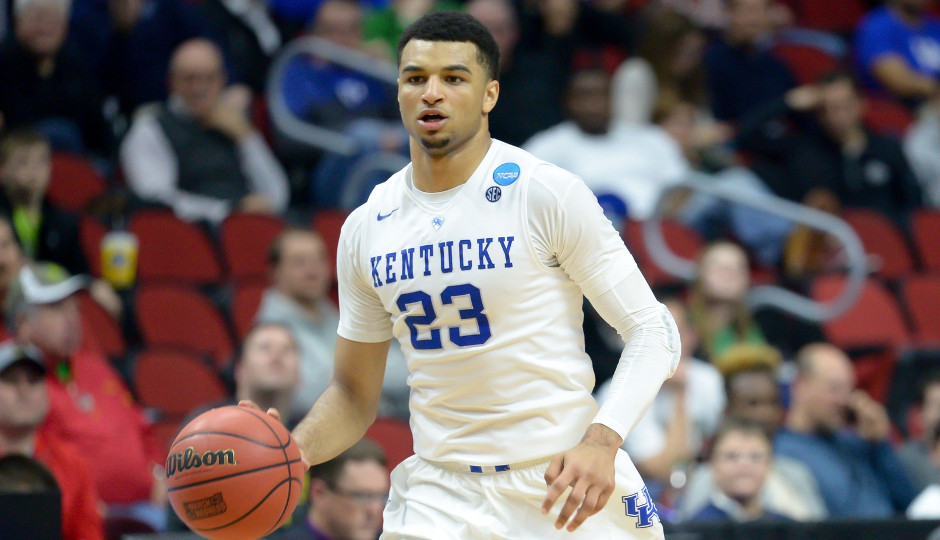76ers Draft: Is Jamal Murray the Draft’s Best Shooter?

Kentucky’s Jamal Murray could be an option if the Sixers acquire another top-5 draft pick in Thursday’s NBA draft | Steven Branscombe-USA TODAY Sports
With the 76ers draft just a few days away, we’ll take a look at a couple of prospects the Sixers could end up walking away with on Thursday night.
In Jamal Murray‘s case, the interest would likely stem from a trade, as he’s unlikely to be, and shouldn’t be, in consideration for the #1 pick.
Age: 19
Measurements: 6-foot-4.25-inches (in shoes), 207 pounds, 6-foot-6.5-inch wingspan.
Stats: 20.0 points, 5.2 rebounds, 2.2 assists per game, shot 45.5 percent from the field and 40.8 percent from three-point range.
Advanced stats: 9.1 Boxscore plus/minus, (8.1 offensive, 1.1 defensive), 6.1 win shares (4.4 offensive, 1.7 defensive), 0.194 win shares/40 minutes, 28.3 percent free throw rate, 59.0 percent true shooting.
(Quick glossary: Boxscore plus/minus is an estimate of the points a player adds to his team per 100 possessions above the league average. Win shares is an estimate on the number of wins a player added to his team. Win shares/40 minutes is win shares for every 40 minutes of play, with the average being ~0.100/40 minutes. Free throw rate is the number of free throw attempts per field goal attempt, and true shooting percentage is an attempt to “fix” field goal percentage, factoring in the additional value of the three-point shot and a player’s ability to get to the free throw line to paint a more accurate picture of a player’s efficiency).
Why should you be interested?
Simply put, Jamal Murray is one of the best shooters in the draft. That’s not just because of his 40.8 percent three-point shooting, which came on 7.7 attempts per game, and includes shooting 56 percent on three-point shots in the left corner, one of the most coveted shots in basketball. He’s also one of the best shooters in the country because of his ability to shoot on the move. He shot a borderline ridiculous 56 percent when shooting coming off of a screen, many of which were jump shots. His footwork, balance, and quick shooting mechanics are extremely impressive for a player who just turned 19.
Murray also has some game off the dribble, at least at the college level, with an advanced set of dribble hesitation and misdirection moves. He mixes that in with a stepback jumper that’s hard to defend and an ability to play off the pick and roll, especially as a scorer. Many of these shots were of an extremely high degree of difficult, which gets Murray labeled as a “shot maker”, which was certainly true in college. You can see from the data below just how many of Murray’s two-point jump shots were not assisted, a testament to his ability to create for himself and his overall high skill level.
| Stat | 3 Pointers | 2-point Jumpers | At Rim |
|---|---|---|---|
| FG% | 40.8% | 39.1% | 65.5% |
| % assisted | 89.4% | 13.6% | 27.8% |
| Quantity Made | 113 | 59 | 72 |
Murray is frequently described as a subpar athlete, something which holds quite a bit of merit. But he does show the ability to elevate around the basket, especially when he gets a head of steam, finishing in impressive fashion at times. He also adds in touch on a floater and a runner in the lane. Overall he shot 65.5 percent on shots at the rim, with just over 20 percent of those makes being assisted.
Murray also has good court vision and is a willing passer. It’s uncertain how much of that will translate to the next level (we’ll talk about that below), but having another player who can make good decisions with the basketball is always welcomed.
Finally, Murray is, by all accounts, an extremely hard worker who is dedicated to his craft and coachable. Whether or not that allows him to overcome the physical limitations we’ll detail below remains to be seen, but it’s certainly a positive. Some players have success in college because they’re physically superior to their competition. Jamal Murray had success as an 18/19 year old because his skill level was more advanced than the competition.
Why shouldn’t you be interested?
Athleticism.
Jamal Murray has athleticism concerns that threaten his effectiveness on both ends of the court.
Murray’s physical profile is the first place to start, as at just 6-foot-4 Murray is undersized for the two, and doesn’t have the elite wingspan to make up for it. That right there presents some limitations to overcome on the defensive side of the court.
When you add in the fact that Murray is relatively slow-footed for a guard, with struggles changing direction, moving his feet laterally, and getting into a good defensive stance, and the overall defensive picture is pretty bleak. Murray will give effort on the defensive side of the court and has good-enough awareness, but his athletic and physical limitations were something he struggled to overcome in the SEC, and are likely to be even more pronounced at the NBA level.
If the concerns were limited to just the defensive side of the court, you would probably live with that concern. But his athletic profile has the chance to limit him offensively as well.
Murray really struggled to turn the corner against some of the stronger defensive teams, with the NCAA tournament game against Indiana sticking in the back of the mind of anybody who watched it. Not only did Murray struggle to turn the corner and get by the first line of defense, but he struggled to get open off the ball as well, running around desperately trying to lose his man, usually to no avail.
People will frequently compare Murray to combo-guards like C.J. McCollum. I just don’t see it. McCollum, to me, is certainly quicker with the ball in his hands, a key factor for somebody to succeed in this mold.
Those struggles turning the corner weren’t just limited to the elite teams he faced, however. Getting by the initial line of defense and forcing the defense to collapse was something he more or less struggled with throughout the year, and why his game really blossomed when he was moved off the ball and allowed to utilize screens more frequently. He still had some success, as his misdirection, hesitation, and step-back games are very advanced. He’s a “shot maker”, and has the talent level to overcome his deficiencies at the college level. The question is whether he can make those same shots against the NBA size and athleticism that is becoming increasingly required for teams that want to switch everything on the perimeter. If Murray can’t get by his man consistently, making shots against guys 1-to-2 (or more) inches taller is going to be a tough way to make a living.
The struggles to get by that initial layer of defense also limit one of his legitimate strengths: his passing. If the defense isn’t forced to collapse, Murray is going to have less passing avenues available to him.
Finally, there’s one additional concern I have with Murray: the low release point on his shot. This is already likely to be an issue in that he’s undersized for his position, but he also has an in-front-of-his-face release point that is low even for his height. The angle of his shot is going to necessitate he get even more space to get his shot off, something which is of concern not only because of how much he relies on his shot to be effective but also because creating space is one area he could struggle with in the NBA.
Fit with the Sixers
Murray’s potential fit with Simmons is one reason you might be willing to overlook Murray’s athletic concerns.
There’s certainly some merit to that. Murray adapted his game at Kentucky and proved to be an elite off-the-ball scorer, at least at the college level. Somebody who can be effective without the ball in his hands, move to get himself open, and provide spacing can be really effective next to an elite passing forward like Ben Simmons, and the open shots Simmons can create for Murray, and the space Murray can create for Simmons, has a synergistic nature that’s very tempting to pursue.
The question is exactly how much of that scoring potency will carry over against NBA size, athleticism, and defensive schemes. Murray’s a highly skilled, hard working kid, and that gives you optimism. But some of the concerns I laid out in his ability to turn the corner with the ball in his hands, to create offense for himself and others, and even to generate the space to get his shot off against NBA defenses is of legitimate concern to me.
That last part, especially, wouldn’t be of such concern to me if I had more faith in the rest of his game translating. But for a player who is very likely to be a negative defensively, who doesn’t have the versatility to switch on defense, and who is unlikely to create offense for his teammates at a high rate, he has to be able to consistently get his shot off at a high level.
Ultimately, if Murray can still shoot 40 percent on a high-volume of three-point attempts, he’s going to be a valuable NBA player, especially next to Ben Simmons and, hopefully, Joel Embiid. The problem is he has almost no margin for error. If he struggles at all to get that shot up against NBA defenses with the kind of consistency he had in college, I just don’t see his ability to create off the dribble and defensive contributions being enough to be an impact player.
Murray has to be an elite shooter, in my mind. That’s a tough standard to live up to.
Derek Bodner covers the 76ers for Philadelphia magazine. Follow @DerekBodnerNBA on Twitter.


